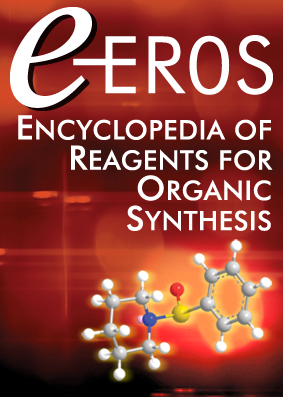Allyl Trifluoromethanesulfonate
Abstract
[41029-45-2] C4H5F3O3S (MW 191.16) InChI = 1S/C4H5F3O3S/c1-2-3-10-11(8,9)4(5,6)7/h2H,1,3H2 InChIKey = XAWVLWQXWMTMGJ-UHFFFAOYSA-N
(extremely reactive allylating agent;1, 2 attacks a variety of S-, P-, N-, or O-containing molecules;2 ring expansion reaction3)
Alternate Name: allyl triflate.
Physical Data: d 1.47 g cm−3.
Solubility: sol chlorinated hydrocarbons.
Form Supplied in: colorless liquid.
Analysis of Reagent Purity: IR (neat, cm−1) 2970 (w), 1413 (m), 1281 (s), 1248 (s), 1194 (s), 1149 (m), 913 (m); 1H NMR (CCl4, ppm) δ 6.03 (m, 1H), 5.43 (m, 2H), 4.92 (m, 2H); 19F NMR (ppm) φ 74.5 (s).
Preparative Methods: allyl triflate is prepared by the reaction of Trifluoromethanesulfonic Anhydride (1 equiv) and allyl alcohol (1 equiv) in the presence of pyridine (1 equiv) in carbon tetrachloride at 0 °C.1 The insoluble pyridine salt is removed by filtration through sodium sulfate, and the resulting solution is used directly for allylation reactions. The yield of the reaction is reported to be 75 ± 5% based on quantitative NMR analysis of aliquots.
Purification: a pure sample may be obtained by distillation (safety shield).2 The product must be trapped in a cold receiver (−78 °C).
Handling, Storage, and Precautions: allyl triflate must be stored at −78 °C in a vented flask. The half-life of the neat reagent is ∼10 min at room temperature, and the reagent in carbon tetrachloride solution completely decomposed in 3 days at room temperature. Allyl triflate reacts violently with nitrogen, or oxygen-containing solvents such as DMSO, DMF, or acetonitrile. The reagent is an extremely reactive allylating agent, and contact or inhalation should be avoided. Use in a fume hood.



